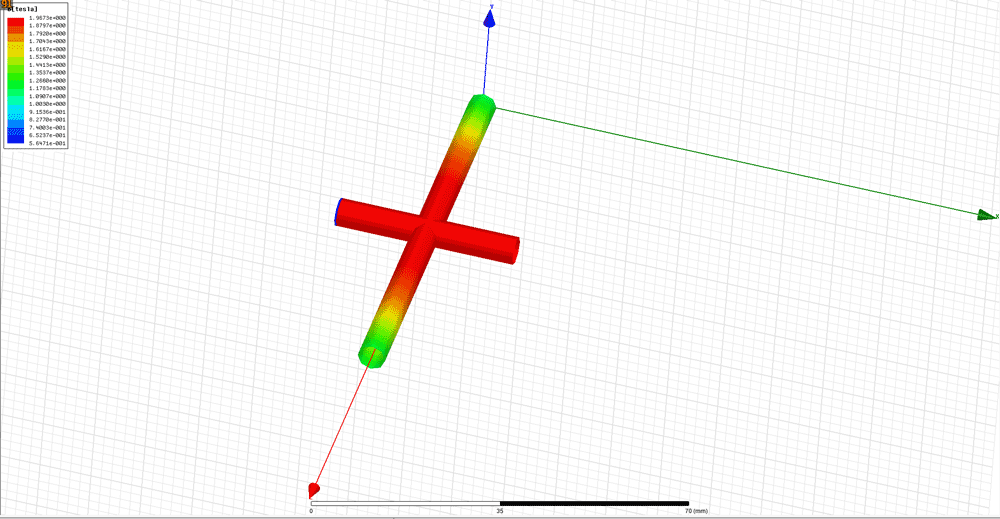Magnetic Field Simulation

Table of Contents
Magnetic field simulation is an important tool for magnet makers and users. This article will explore how magnetic field simulation works and how it can help design and build better magnet systems.
1. Understanding Magnetic Field Simulation
A. Magnetism Basics
It’s hard to make sense of magnetic field simulation results or set up a good simulation without knowing some magnetism basics. For example, you might misunderstand the results if you don’t get how magnets work. Or you might set up the simulation wrong if you don’t know about the type of magnet you want to simulate.
1). Core Magnetism Ideas
If magnetism is new to you, learn some key laws and principles of how magnetic fields behave. These include things like magnetic poles, magnetic flux, and magnetic field strength. Also, how different magnetic fields interact. Understanding these basics is key to how magnetic field simulation works. It helps you get what the simulation is modeling and how it predicts how magnetic fields act.
2). Different Kinds of Magnets
There are many types of magnets, like permanent magnets (neodymium or ferrite), electromagnets, and induced magnets. Each acts in its own way.
Knowing how these magnet types differ, including their magnetic field strength, shape, and size, helps predict how they’ll act in different situations. The type of magnet you simulate has a big effect on the results. Understanding different magnet types means you can set up simulations better and figure out the results.
B. What is Magnetic Field Simulation?
Definition and Goal
Magnetic field simulation is a computer tool that figures out magnetic field patterns and details for a specific magnet system design. It uses math techniques to solve Maxwell’s equations, which describe how electromagnetism works under certain conditions.
Simply put, you give details about your magnet system, like size, shape, and layout of magnets and metal parts, materials used, electric currents or magnetic fields applied, etc. The software then virtually prototypes your design, breaking it into many small pieces (meshes), and calculates the magnetic field strength and direction everywhere.
Real-World Uses
Magnetic field simulation gives visual results of the magnetic field as field lines or contour maps, and numerical results like magnetic flux density, highest field intensity, forces, inductance, etc. This lets you analyze how your magnet system may work and improve the design before building a physical prototype. This can optimize your product and cut down development time and cost.
Magnetic field simulation tools have gotten much more advanced in recent years, with many options at different levels of complexity and price. They have become easy enough for any magnet designer or user to use for their projects. Simulation provides valuable insights into your magnetic system and predicts how it may act with high accuracy.
Importance for Magnet Users and Buyers
In short, magnetic field simulation calculates the magnetic field in and around your magnet system design based on what you input. It is a virtual prototyping tool that gives both visual and numerical results for thoroughly analyzing and optimizing your magnet system. The benefits of using magnetic field simulation are huge, especially reducing waste and speeding up development.
2. Using Software for Magnetic Field Simulation
The ability to simulate and predict how magnetic fields act virtually is a huge leap forward. It has a big impact on many industries. But you don’t need to be an experienced engineer or magnetism expert to get the basics of these simulations. Here, we’ll look at some common software for magnetic field simulations and explain how these tools predict how magnets will act.
Autodesk Inventor
This software is widely used for 3D modeling, including making digital models of magnets and magnetic assemblies. With Autodesk Inventor, you can design and see your magnet or assembly in action before simulating.
EMS
If you want an easy solution for magnetic field simulations, check out EMS. This user-friendly software lets you set up and run basic simulations. It gives you useful insights into how your magnetic field may act.
Maxwell
For detailed and precise simulations, Maxwell is the top choice. Its advanced features offer high accuracy, making it great for professional simulations.
Understanding How Simulations Predict Magnet Behavior
Magnetic field simulations depend on accurate calculations to predict how magnets will act. Correct modeling is key since what you input directly impacts the results. Running a simulation lets you anticipate how a magnet may act under different conditions.
Factors Affecting How Magnets Perform
Different magnet types have properties that determine how they perform. For example, neodymium magnets act differently than ferrite magnets. Also, environment conditions like temperature and humidity can affect how magnets perform. Finally, boundary conditions, which define the space for the simulation, can significantly change the results.
Understanding these factors helps you make sense of simulation results and use them to decide which magnets to choose and how to use them.
Whether you’re a hobbyist, student, or just curious about the fascinating world of magnetism, understanding these simulations can open up lots of possibilities.
3. Benefits of Magnetic Field Simulation
A. Predicting How Magnets Will Act
Figuring Out Magnetic Field Strength and Direction
A big benefit of magnetic field simulation is helping users and buyers understand a magnet’s field strength and direction without testing it physically. This is especially useful with big or pricey magnetic assemblies where physical testing takes time and costs a lot.
Predicting Performance in Different Conditions
Magnetic field simulations can also simulate different environments and how something is used. This allows users and buyers to predict how a magnet may perform under those conditions. This helps spot possible issues ahead of time and make sure the chosen magnet or magnetic assembly will work well for its intended purpose.
B. Helping Choose Magnets
Picking the Right Magnet for What You Need
By simulating how different magnet types may perform under various conditions, users and buyers can make better informed choices about which magnet best suits their needs. For example, a buyer could use a simulation to decide between neodymium and ferrite magnets for a specific use based on how they might perform under the simulated conditions.
Judging Quality and Value
Finally, magnetic field simulations can help users and buyers determine a magnet or magnetic assembly’s quality and value. For instance, a simulation may show a more expensive magnet performs a lot better than a cheaper one for the intended purpose, suggesting the pricier magnet is worth the extra cost. On the other hand, a simulation may show a cheaper magnet performs well enough for the intended purpose, indicating it offers better value.
In short, magnetic field simulations provide useful insights to guide users and buyers in choosing magnets. They help make better informed decisions and get the most for the money.
4. Limits of Magnetic Field Simulation
A. Accuracy Concerns
Shortcomings of Simulation Models
Magnetic field simulations rely on math models that simplify how things work in the real world. These models make assumptions to make the math and computing manageable. So, there can be times when the model fails to fully capture how something works in a real-world situation, leading to inaccuracies in the results.
How Accurate the Input Is Affects Accuracy
How accurate a simulation is depends a lot on how accurate the input is. If there are errors or uncertainties in what is input (such as properties of the magnet, conditions around it, or boundary conditions), these can carry through the simulation and affect the accuracy of the results.
B. Practical Considerations
Time and Computing Power Required
Simulations, especially those involving complex systems or needing to be very accurate, can require a lot of computing power and time. This can be a limit in cases where results are needed quickly or available computing resources are limited.
Need for Expertise to Run Simulations
While user-friendly software is available, running a magnetic field simulation and understanding the results often requires a certain level of expertise. Without this expertise, there is a risk of setting up the simulation incorrectly or misinterpreting the results, which can lead to inaccurate predictions and potentially costly mistakes.
So, while magnetic field simulations are a powerful tool, these limits must be kept in mind when using the results to make decisions.
Conclusion
Magnetic field simulation is an invaluable tool that offers numerous advantages for designers and users of magnet systems.
At Osenc, we utilize magnetic field simulation to deliver high-quality bespoke magnets and magnetic assemblies. Through simulation, we can refine your design, enhance performance, preempt issues, and curtail costs, all before the commencement of the manufacturing process.
While simulations have their limitations and cannot reproduce all real-world conditions, contemporary tools have grown considerably sophisticated, precise, and accessible. At Osenc, we employ simulation to acquire a comprehensive understanding of your magnet system’s behavior and performance. Through simulation, we can create superior custom solutions more swiftly and cost-effectively. We can identify and rectify issues early in the process when they are simpler to amend.
What sets Osenc apart from many magnet suppliers is our capability to conduct magnetic field simulation services for your custom designs. In essence, if you work with magnets or magnetic systems, you will derive substantial benefits from Osenc’s magnetic simulation capabilities. It empowers you to work more efficiently, make decisions with greater confidence, and construct solutions that may have seemed unattainable otherwise.
In conclusion, magnetic field simulation offers a multitude of benefits with substantial implications. While supplementing but not superseding physical prototyping, it provides a virtual prototyping environment where we can construct, test, analyze, optimize, and improve your magnet system designs to attain peak performance. By facilitating a faster, more economical and smarter design process, magnetic field simulation is a crucial tool that Osenc uses to provide the best custom magnet solutions for you.
With Osenc as your magnet ally and magnetic field simulation at our disposal, your products will attain unprecedented levels of performance and efficiency. Allow us to cater to your magnet requirements – we possess the capability to simulate, optimize, construct, and deliver high-quality custom magnetic assemblies for you.


I’m Ben, with over 10 years in the permanent magnet industry. Since 2019, I’ve been with Osenc, specializing in custom NdFeB magnet shapes, magnetic accessories, and assemblies. Leveraging deep magnetic expertise and trusted factory resources, we offer one-stop solutions—from material selection and design to testing and production—streamlining communication, accelerating development, and ensuring quality while reducing costs through flexible resource integration.


